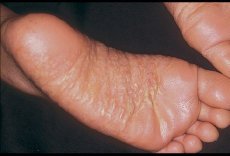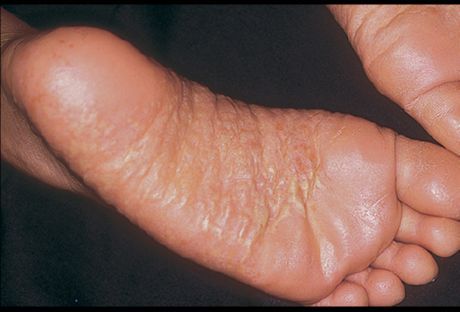Medical expert of the article
New publications
Foot dermatitis - and how to deal with it?
Last reviewed: 04.07.2025

All iLive content is medically reviewed or fact checked to ensure as much factual accuracy as possible.
We have strict sourcing guidelines and only link to reputable media sites, academic research institutions and, whenever possible, medically peer reviewed studies. Note that the numbers in parentheses ([1], [2], etc.) are clickable links to these studies.
If you feel that any of our content is inaccurate, out-of-date, or otherwise questionable, please select it and press Ctrl + Enter.

What is dermatitis of the feet? The dermis is the skin. When it is strongly irritated, the skin of the feet becomes inflamed and very painful. Transparent blisters appear on the skin, the skin cracks, and these are the first signs of dermatitis of the feet. What to do?

Dermatitis of the legs and its causes
It is not always possible to determine the causes of dermatitis on the legs. But its manifestations are immediately noticeable. These are cracks and blisters on the skin, there may be a change in its color, there may be pimples on the skin, these areas may hurt and itch.
Dermatitis on the feet can be caused by wearing uncomfortable shoes, in which the foot sweats, becomes irritated and injured due to the uncomfortable position of the foot. Dermatitis can also be caused by wearing synthetic socks, stockings and tights.
They do not allow the foot to breathe, cause increased sweating, such an environment promotes the rapid proliferation of pathogenic bacteria and deterioration of the skin condition.
What to do with dermatitis of the legs
First of all, you need to remove mechanical irritants from your feet. That is, do not wear uncomfortable shoes, synthetic socks, or treat your clothes with powders that contain harmful chemicals. It is better to wash socks and tights with regular laundry soap or expensive bio-powders without phosphates.
Excellent remedies for dermatitis of the legs are taking vitamins. They improve the condition of the skin, and at the same time the internal organs, and will start the process of more active metabolism. Vitamins B, A, E, C, D are what is needed in combination to improve the condition of the skin with dermatitis.
If dermatitis on the legs is accompanied by itching, you need to buy antihistamines on the recommendation of a doctor. They will help cope with itching and the feeling of discomfort with dermatitis.
Itching in dermatitis of the legs can also be relieved with ice. Freeze several ice cubes in the refrigerator and wipe the sore spots with them. The itching in the affected areas should disappear after a short time.
Traditional methods of combating dermatitis on the legs
Take one part of hop cones and one part of celandine, mix them together. To start, one teaspoon of each will be enough. Then boil 150 grams of water and pour it over the grass. It is better to do this in the morning so that the infusion is ready by evening.
Let the infusion sit for 5-6 hours – so that it steams well, it needs to be wrapped up. Strain the infusion, warm it up until hot and drink before dinner. Then go to bed, wrapping the affected areas with a cloth soaked in the same infusion.
Repeat this procedure every morning and evening, and in a week you will feel significant improvements. And in 2 weeks the dermatitis will subside.
To combat foot dermatitis, you can use a very simple but reliable, centuries-tested remedy: oak bark. More precisely, its decoction. Oak bark should be poured with hot water and brought to a boil. Then the decoction should be left to infuse for 5-6 hours. After this, wet a cloth with oak bark decoction and apply it to the affected areas.
You can do this at night, or you can wash the wounds with oak bark decoction. In a week, you will see significant results. The skin will calm down and acquire a healthy color. To reduce itching, you can take a comprehensive approach: take antihistamines as well.

Viburnum will also cure skin with dermatitis on the legs. You need to pour 2 spoons of its berries into a wooden (not metal!) mortar and grind. Then you need to boil water and pour it over the berries. One glass of boiling water will be enough. Let the viburnum infuse for 4 hours. If you drink this infusion 1/2 glass 4 times a day before meals, the dermatitis will give up its positions very soon.
You can wash the areas affected by dermatitis with natural cranberry juice – and soon you will forget about this disease. At least, this is how our ancestors treated skin diseases.
Burdock, or agrimony, is good against dermatitis on the legs. You need to dig up its root (this is done in the fall, when the burdock root comes into force, but it can also be done in the summer). The root needs to be crushed, a teaspoon of it poured with 500 grams of boiling water. Then wrap it up and let it brew throughout the night. Then this decoction can be filtered and drunk half a glass warmed up 4 times a day before meals.
Burdock infusion can be made in a different way, but not for internal use, but for external use. To do this, pour a teaspoon of crushed burdock root with one glass of boiling water, put on low heat and boil for 30 minutes. Then cool the decoction, filter and make compresses on skin areas affected by eczema.

Buy sea buckthorn oil - it is also a great helper against dermatitis on the legs. You need to take sea buckthorn oil orally, 2 milliliters per day. It can be divided into two doses - in the morning and in the evening before meals. Sea buckthorn oil is also very good as a compress. You need to apply it to the affected area of the skin for a couple of hours or all night. This can be not only oil, but also sea buckthorn ointment with a concentration of five percent.
Rose hips are not only a storehouse of vitamins, but also an excellent fighter against dermatitis. If you take rose hips, crush them with a mortar in a wooden or any other container, but not a metal one (kills vitamins), and then apply them to the areas affected by dermatitis, this will heal the diseased skin of the legs in a short time.
Egg yolks also actively help against dermatitis. Eggs should be hard-boiled (10 minutes of boiling). Then the eggs should be cooled, the yolks removed, pricked with a fork and held over a burning candle. A small plate or cup should be placed underneath to collect the liquid from the yolks.
This liquid will drip from the yolk when heated, the so-called yolk tears. Of course, you will have to spend time, and you will need a lot of eggs. You need to lubricate the affected areas of the skin with these yolk tears, like an ointment. Cover with sterile gauze or bandage. Let them act throughout the night. In the morning, you can change the bandage and leave it for another day. Continue this until the skin recovers and pleases you with its freshness and smoothness.
To make your feet skin beautiful and get rid of dermatitis, you need to take foot baths from this herbal collection. Take succession, pharmacy chamomile, valerian (root), sage (leaves), St. John's wort, celandine. You need one equal part of each ingredient.
Now pour boiling water over this herbal mixture (5 liters of boiling water per 100 g of mixture), leave for 40-45 minutes. Then you can strain the infusion and pour it into a container in which you will soak your feet. Preheat the infusion to 38 degrees. Your feet should be in the container for 20 minutes. Using this procedure every day, you can cope with dermatitis.

Corn silk can help not only in the treatment of kidneys, but also in the fight against dermatitis of the legs. Here is how to prepare an infusion with them. Take sage, nettle, plantain, 2 parts of each herb, use the leaves, not the root. Then throw one part of wormwood and two parts of corn silk, corn silk and juniper berries into the mixture.
Add three parts of St. John's wort, yarrow, and horsetail to them. Pour boiling water over this infusion and let it sit overnight. Then strain and drink one-third of a glass a day before each meal (ideally 3 times). This will help reduce itching in dermatitis and improve the skin condition.
Chicory, bogbean leaves, dandelion root, fennel berries and buckthorn bark will help to cope with unpleasant rashes on the skin of the legs and itching, as well as wounds. You only need to take these plants in equal quantities, pour boiling water over them and leave for 5-6 hours. Take, strain, before breakfast and before dinner every day. The course of treatment is 1-2 weeks, and the dermatitis on the legs will be gone. If necessary, the course of treatment can be continued.
 [ 9 ]
[ 9 ]

